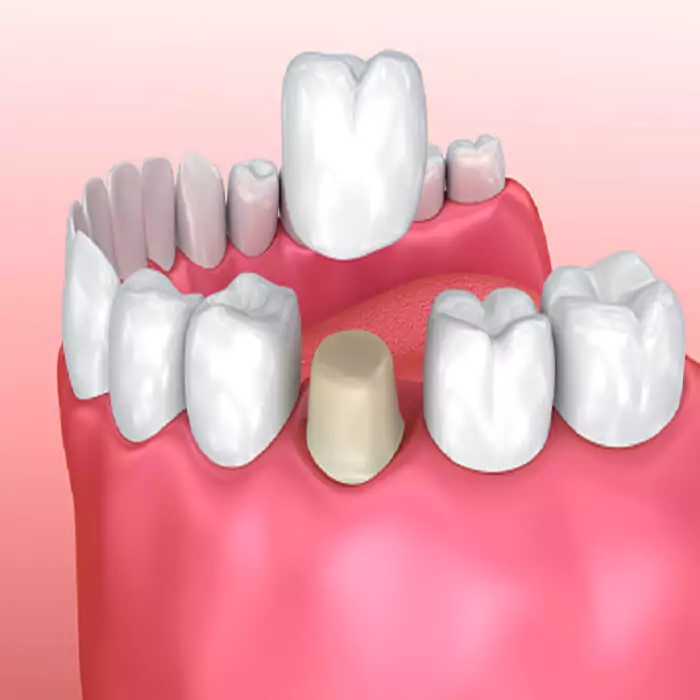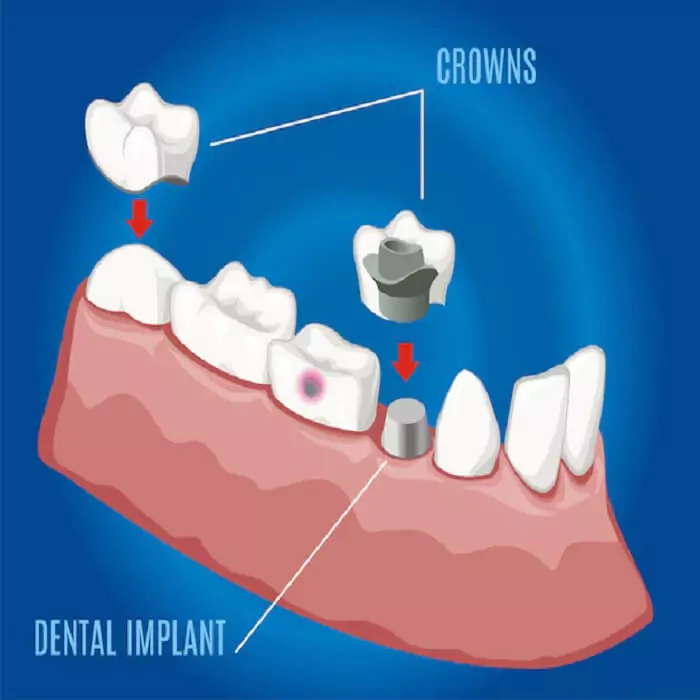Dental Crown Clinic Ahmedabad

Dental Crown & Bridge
If you have one or more missing teeth, getting artificial replacements is the best option to get your natural look back. There are removable choices, such as dentures, that you can take out and clean, but they slide around, move, or fall out, which many people won’t enjoy. Here comes the existence of dental crowns affixed to dental implants and dental bridges that operate more like your natural teeth. Even though you have a fake tooth or two, you will have as real a smile as possible. We at Bright White Dental Clinic & Implant Center believe that teeth play a vital role in day-to-day life. We always work our best to deliver the best results to our patients. At our clinic, we always aim to create a comfortable, pain and anxiety-free environment.
What are Dental Crowns?
A dental crown is used to cover a damaged or decayed tooth or to replace a missing tooth when it is placed on top of a dental implant. Dental implants are titanium anchors that are surgically attached to the jawbone beneath the gums. By the process of Osseointegration, these dental implants become attached to the jaw bone. This process provides strong support to rely on when eating and speaking. It takes around 6 – 12 weeks for a dental implant to heal properly. After that abutment is placed on the dental implant on which a dental crown is mounted.
- Have very large filling bigger than natural teeth structure
- Had root canal therapy
- Have a combination of both root canal and large filling
- Need a dental crown for cosmetic reasons


Need of Having a Dental Crown
Before getting a dental crown for a damaged or decayed tooth, the impression of your bite is taken. Based on that, the shape of your new tooth can be determined. Depending on the material you choose, your dental crown can be made in a single day or might take a few weeks.
- Dental crowns save severely damaged or decayed teeth
- Dental crowns protect a dead or weak tooth from falling
- For a tooth with a history of decay, dental crowns are the best protection
- Dental crowns are a versatile cosmetic treatment
- Dental crowns are robust and give a long-lasting protection
- Having dental crowns improves your chewing and eating when you have any lost teeth.
- Dental crowns strengthen a tooth with fillings.
- Dental crowns improve a discoloured tooth
We are proud to spread 3200+ smiles across the families and believe to give the genuine opinion to the patients for consistent faith with Bright White Dental Clinic & Implant Center.
FAQ's
On an average a Dental Crown and a Bridge lasts for about 15 years if the treatment and material is properly performed. With a good oral hygiene, maintenance and regular check-ups it can last up to 25-30 years also.
Dental Bridges are recommended when one or more tooth is lost entirely. Whereas, Dental Crowns are recommended to restore cracked or fractured tooth.
There are few disadvantages of Dental Bridges that one should keep in mind
Traditional and cantilever bridges both require healthy teeth to be altered. For the dental crowns to fit properly, dentists must remove a small bit of enamel from the healthy surrounding teeth during implantation. These teeth may cause complications for patients in the future.
Bone loss is not addressed by bridges. The jawbone in those places begins to degenerate when a person has one or more missing teeth, producing facial drooping, tooth movement, and subsequent tooth loss. The only approach to inhibit bone resorption and grow back that bone tissue is to replace the tooth root with a dental implant. The jawbone will continue to degenerate since bridges are placed above the gum line.
Bridges do not survive as long as implants. Dental implants are predicted to endure more than 25 years, while bridges are projected to last only a few years.
There are three main types of dental bridges traditional fixed bridges, cantilever bridges and Maryland bonded bridges. Traditional fixed Bridge is the most common or popular type of dental bridge which has false teeth that are held in place by crowns. In Cantilever Bridge the false teeth are held in its position with the help of a dental crown which is cemented to one abutment tooth. In Maryland Bonded Bridges two natural abutment teeth on each side of the space like traditional braces.
There are 4 main steps involved in preparing Dental Crowns. 1. Tooth Preparation, 2. Taking the Impression, 3. Placing a Temporary Crown, 4. Cementing a Permanent Crown Dental Bridge also more or less follows the same procedure.


